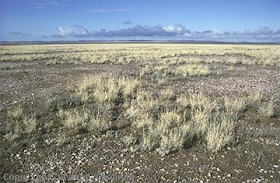Recently I've been thinking about my favourite biome - the grasslands - and when they came to prominence in Australia. Was it because of megafauna? Was it because of climate? Was it because of Aboriginal burning? So, I started reviewing the literature and thought I'd share my findings here. It's a fascinating topic and one that I'm pretty sure most biologists / grassland aficionados /ecologists aren't entirely familiar with.
 |
| Mitchell Grass grasslands - widespread in north-eastern Australia, but when did they come to prominence? |
Grasses originated in Gondwana during the Cretaceous (>65 million years ago (Ma)) with some speculation that graminoids possibly originated in East Gondwana, notably the area that later became Australia. In Australia, however, there are almost no early preserved grass macro-fossils, possibly due to the bias towards their preservation in wet environments. The earliest record of Australian grass pollen is from the mid Eocene (~45 Ma), but it has always been relatively sparse in the Australian fossil record, only becoming most abundant within the last 2 million years.
Grass pollen first occurs in north-western Australia, possibly forming savannah by the mid-Miocene (~15 Ma). The expansion of open vegetation types accelerated in the late Miocene due to increased climate seasonality. There were rapid evolutionary radiations in many large Australian groups such as the sclerophyll taxa Eucalyptus, Banksia and Allocasuarina at this time, as well as grasses. Austrostipa, for example, originated and began to diversify between 25 and 10 Ma, and a rapid radiation occurred, indicated by a high diversification rate at that time. Increasing taxonomic diversity may have resulted from adaptation to newly derived arid niches caused by climatic changes.
From north-west
 |
| Themeda triandra - one of the most widespread C4 grasses in Australia |
Many grasses that are now common in
C4 grasses extended into the temperate regions of the south of Australia, most notably, Themeda, the genera that subsequently became the dominant mesic grassland type in the south-east of the continent. In southern Australia, however, grasses did not achieve their current prominence until the Late Pleistocene. Explanations for the C4 expansion across the landscape in the Miocene have invoked changes in the seasonality of climate, particularly climate drying, given the C4 pathway appears to give grasses a competitive advantage in arid environments, and to changes in fire regimes. Increases in the abundance of the major C4 clades Paniceae and Andropogoneae were thought most favoured by these changed conditions, although the reasons for the rise of C4 grasslands per se are still debated. New research, for instance, suggests that the C3 Pooideae (which include the Stipeae) expanded into cooler climates rather than being outcompeted by C4 grasses, an event that is possibly as important as the global C4 expansion.
Further Reading
Jacobs, B.F., Kingston, J.D. & Jacobs, L.L. (1999) The origin of grass-dominated ecosystems. Annals of the Missouri Botanical Garden 86, 590-643.
No comments:
Post a Comment